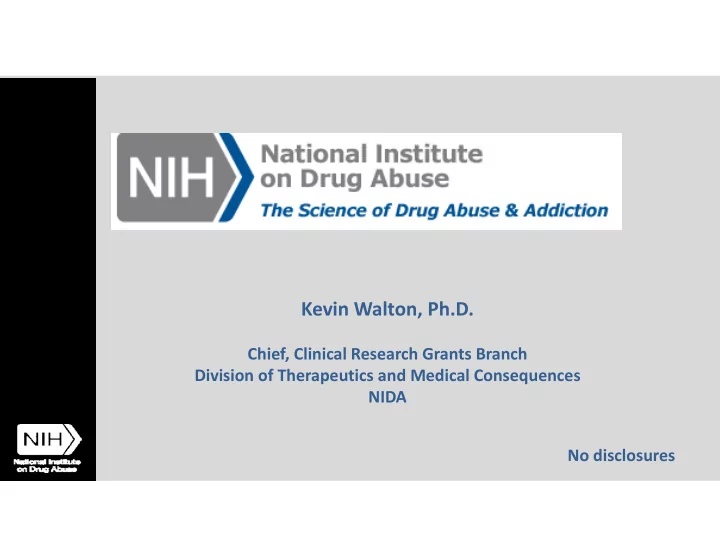

Kevin Walton, Ph.D. Chief, Clinical Research Grants Branch Division of Therapeutics and Medical Consequences NIDA No disclosures
NIDA Organizational Chart Office of Diversity & AIDS Research Health Disparities Office of Program Office of Translational the Director International Initiatives & Program Program Innovations Office of Science Policy & Division of Intramural Management Communications Extramural Research Research Program Division of Therapeutics and Division of Neuroscience Medical Consequences and Behavior Center for the Clinical Trials Division of Epidemiology, Services Network and Prevention Research Trans ‐ Division Research Teams
1. Basic Science: Identify the biological, environmental, behavioral, and social causes and consequences of drug use and addiction across the lifespan. 2. Prevention: Develop new and improved strategies to prevent drug use and its consequences. 3. Treatment: Develop new and improved treatments to help people with substance use disorders achieve and maintain a meaningful and sustained recovery. 4. Public Health : Increase the public health impact of NIDA research and programs.
2016 Monitoring the Future Study Key Findings ‐ Prevalence (2015 to 2016)
Steady Decline in Past Month Cigarette Use
Teens more likely to use e ‐ cigarettes than combusted cigarettes
Adult E ‐ cigarette Use • Population Assessment of Tobacco and Health (PATH) – Longitudinal, comprehensive effort documenting tobacco use – 45,971 adults and youths, 12 years of age or older • Current use ‐ daily or some days (weighted percentages) 18 ‐ 24 yo >25 yo 18 ‐ 24 yo >25 yo (DAILY) (DAILY) Cigarette 19.6% 17.9% 14.7% 16.2% E ‐ cigarette 8.9% 5.0% 1.3% 1.2% • Based on US population numbers (Census bureau) – About 37 million use cigarettes daily – About 3 million use e ‐ cigarettes daily
Questions About E ‐ cigarettes How safe are they? Are they addictive? Are they a gateway to smoking? Do they have a role for harm reduction and cessation? What are the issues for vulnerable populations: youth, mental illness, pregnancy? How to answer these questions? • Often requires preclinical and clinical studies. • Need devices with known aerosol / delivery characteristics. • Clinical studies often need FDA review, requiring a detailed data package describing the device. • Uncertain availability of a commercial device thru a study.
How is NIDA facilitating e ‐ cigarette research? • In 2014, NIDA issued a contract solicitation (SBIR) to develop a Standardized Research E ‐ Cigarette (SREC) with an associated data package. • Four companies received Phase 1 contracts, NJOY LLC will be the first to complete Phase 2. • Devices and refills will be available by 4Q 2017. • NJOY will sell the SREC directly to researchers together with permission to reference the data package for FDA submissions.
Key features of the SREC • E ‐ liquids made under GMP ‐ like conditions (to allow use in clinical studies). • Fully characterized e ‐ liquid and aerosol. • Tobacco flavor, nicotine ‐ containing and placebo e ‐ liquids. • Unique battery connector and sealed cartridges limit use to the characterized e ‐ liquid. • Reproducible aerosol delivery from start to end of cartridge & battery charge. • Demonstrated nicotine delivery (pharmacokinetics).
Technical Characteristics SREC COMMERCIAL 1 2 E ‐ LIQUID Puffs (3 s) per > 350 Variable Cartridge Nicotine 15 mg/mL 7 ‐ 21 mg/mL Concentration AEROSOL CHARACTERISTICS (per 10 puffs) Nicotine 1 mg 0.3 – 3 mg Formaldehyde 1 μ g 0.6 ‐ 5 μ g Acetaldehyde 0.9 μ g 0.4 – 21 μ g Acrolein 0.2 μ g ? – 1.4 μ g 1. https://www.drugabuse.gov/funding/supplemental ‐ information ‐ nida ‐ e ‐ cig 2. 2016 El ‐ Hellani et al, Nicotine and Carbonyl Emissions From Popular Electronic Cigarette Products: Correlation to Liquid Composition and Design Characteristics. Nic Tob Res
Nicotine Pharmacokinetic Profile (mean ± SD) Defined use Ad lib use Cmax NICOTINE IN PLASMA 64 Own Device SREC t ‐ Test: Paired Two Sample for Means Cmax (ng/ml) Cmax (ng/mL) 32 Mean (ng/ml) 11.08 17.68 Own SREC Own SREC 16 Mean 11.08 17.68 11.08 17.68 Variance 72.71 306.69 71.31 306.69 Variance 71.31 306.69 14 14 (ng/ml) 8 Observations Observations 14 14 14 14 0.21 P(T<=t) two ‐ tail 0.21 4 P(T<=t) two ‐ tail 0.21 t ‐ Test: Paired Two Sample for Means Tmax (min) 2 Tmax (min) Tmax Own SREC Own SREC 1 SREC Mean 9.07 5.71 9.07 5.71 Own Device SREC Variance 42.69 0.99 42.69 0.99 0.5 Own Device 14 14 Observations 14 14 0.06 Mean (ng/ml) 9.07 5.71 P(T<=t) two ‐ tail 0.06 0.25 Variance 42.69 0.99 0 50 100 200 300 400 500 Observations 14 14 TIME (min) P(T<=t) two ‐ tail 0.06
Overall Research Direction Harm Reduction is the current focus • These studies with tobacco products are reviewed by the FDA Center for Tobacco Products (CTP). − We expect a complete SREC Product Master File will support the device’s use as an Investigational Tobacco Product. Smoking/Nicotine Cessation studies are a future goal • This is a therapeutic indication, regulated by the FDA Center for Drug Evaluation and Research (CDER ). − Investigational New Drugs require evidence of safety in animals prior to “First in Human” studies.
Recommend
More recommend